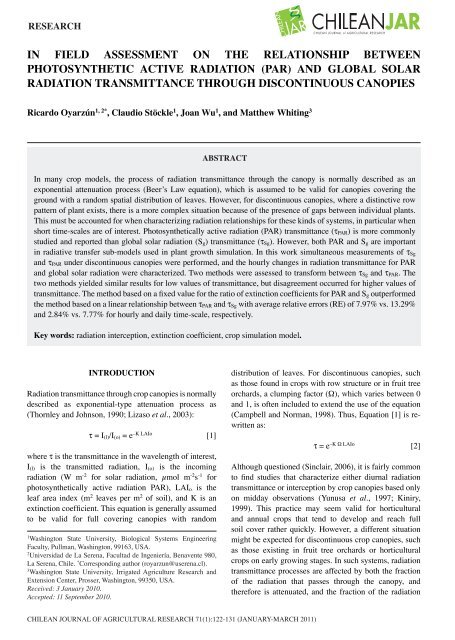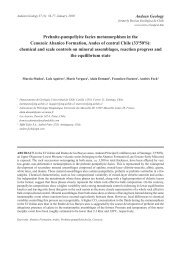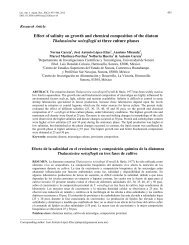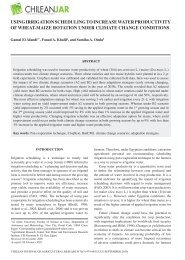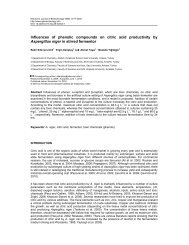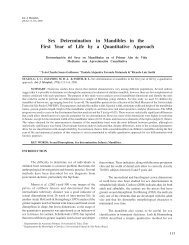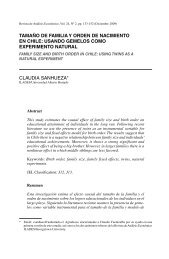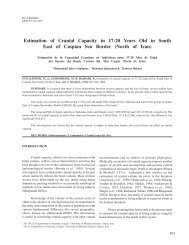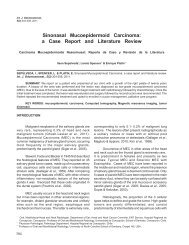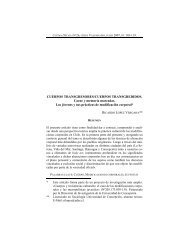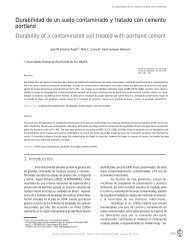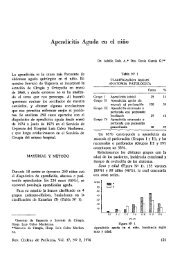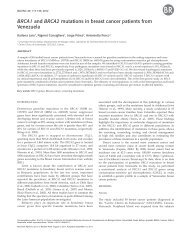(par) and global solar radiation transmittance t
(par) and global solar radiation transmittance t
(par) and global solar radiation transmittance t
You also want an ePaper? Increase the reach of your titles
YUMPU automatically turns print PDFs into web optimized ePapers that Google loves.
RESEARCH<br />
122 CHIL. J. AGR. RES. - VOL. 71 - Nº 1 - 2011<br />
IN FIELD ASSESSMENT ON THE RELATIONSHIP BETWEEN<br />
PHOTOSYNTHETIC ACTIVE RADIATION (PAR) AND GLOBAL SOLAR<br />
RADIATION TRANSMITTANCE THROUGH DISCONTINUOUS CANOPIES<br />
Ricardo Oyarzún 1, 2* , Claudio Stöckle 1 , Joan Wu 1 , <strong>and</strong> Matthew Whiting 3<br />
ABSTRACT<br />
In many crop models, the process of <strong>radiation</strong> <strong>transmittance</strong> through the canopy is normally described as an<br />
exponential attenuation process (Beer’s Law equation), which is assumed to be valid for canopies covering the<br />
ground with a r<strong>and</strong>om spatial distribution of leaves. However, for discontinuous canopies, where a distinctive row<br />
pattern of plant exists, there is a more complex situation because of the presence of gaps between individual plants.<br />
This must be accounted for when characterizing <strong>radiation</strong> relationships for these kinds of systems, in <strong>par</strong>ticular when<br />
short time-scales are of interest. Photosynthetically active <strong>radiation</strong> (PAR) <strong>transmittance</strong> (τ PAR) is more commonly<br />
studied <strong>and</strong> reported than <strong>global</strong> <strong>solar</strong> <strong>radiation</strong> (S g) <strong>transmittance</strong> (τ Sg). However, both PAR <strong>and</strong> S g are important<br />
in radiative transfer sub-models used in plant growth simulation. In this work simultaneous measurements of τ Sg<br />
<strong>and</strong> τ PAR under discontinuous canopies were performed, <strong>and</strong> the hourly changes in <strong>radiation</strong> <strong>transmittance</strong> for PAR<br />
<strong>and</strong> <strong>global</strong> <strong>solar</strong> <strong>radiation</strong> were characterized. Two methods were assessed to transform between τ Sg <strong>and</strong> τ PAR. The<br />
two methods yielded similar results for low values of <strong>transmittance</strong>, but disagreement occurred for higher values of<br />
<strong>transmittance</strong>. The method based on a fixed value for the ratio of extinction coefficients for PAR <strong>and</strong> S g outperformed<br />
the method based on a linear relationship between τ PAR <strong>and</strong> τ Sg with average relative errors (RE) of 7.97% vs. 13.29%<br />
<strong>and</strong> 2.84% vs. 7.77% for hourly <strong>and</strong> daily time-scale, respectively.<br />
Key words: <strong>radiation</strong> interception, extinction coefficient, crop simulation model.<br />
INTRODUCTION<br />
Radiation <strong>transmittance</strong> through crop canopies is normally<br />
described as exponential-type attenuation process as<br />
(Thornley <strong>and</strong> Johnson, 1990; Lizaso et al., 2003):<br />
τ = I (l)/I (o) = e –K LAIo [1]<br />
where τ is the <strong>transmittance</strong> in the wavelength of interest,<br />
I (l) is the transmitted <strong>radiation</strong>, I (o) is the incoming<br />
<strong>radiation</strong> (W m -2 for <strong>solar</strong> <strong>radiation</strong>, µmol m -2 s -1 for<br />
photosynthetically active <strong>radiation</strong> PAR), LAI o is the<br />
leaf area index (m 2 leaves per m 2 of soil), <strong>and</strong> K is an<br />
extinction coefficient. This equation is generally assumed<br />
to be valid for full covering canopies with r<strong>and</strong>om<br />
1<br />
Washington State University, Biological Systems Engineering<br />
Faculty, Pullman, Washington, 99163, USA.<br />
2<br />
Universidad de La Serena, Facultad de Ingeniería, Benavente 980,<br />
La Serena, Chile. * Corresponding author (royarzun@userena.cl).<br />
3<br />
Washington State University, Irrigated Agriculture Research <strong>and</strong><br />
Extension Center, Prosser, Washington, 99350, USA.<br />
Received: 3 January 2010.<br />
Accepted: 11 September 2010.<br />
distribution of leaves. For discontinuous canopies, such<br />
as those found in crops with row structure or in fruit tree<br />
orchards, a clumping factor (Ω), which varies between 0<br />
<strong>and</strong> 1, is often included to extend the use of the equation<br />
(Campbell <strong>and</strong> Norman, 1998). Thus, Equation [1] is rewritten<br />
as:<br />
τ = e –K Ω LAIo [2]<br />
Although questioned (Sinclair, 2006), it is fairly common<br />
to find studies that characterize either diurnal <strong>radiation</strong><br />
<strong>transmittance</strong> or interception by crop canopies based only<br />
on midday observations (Yunusa et al., 1997; Kiniry,<br />
1999). This practice may seem valid for horticultural<br />
<strong>and</strong> annual crops that tend to develop <strong>and</strong> reach full<br />
soil cover rather quickly. However, a different situation<br />
might be expected for discontinuous crop canopies, such<br />
as those existing in fruit tree orchards or horticultural<br />
crops on early growing stages. In such systems, <strong>radiation</strong><br />
<strong>transmittance</strong> processes are affected by both the fraction<br />
of the <strong>radiation</strong> that passes through the canopy, <strong>and</strong><br />
therefore is attenuated, <strong>and</strong> the fraction of the <strong>radiation</strong><br />
CHILEAN JOURNAL OF AGRICULTURAL RESEARCH 71(1):122-131 (JANUARY-MARCH 2011)
R. OYARZÚN et al. - IN FIELD ASSESSMENT ON THE RELATIONSHIP BETWEEN….<br />
123<br />
that passes unobstructed through <strong>and</strong> between canopy<br />
gaps, which varies greatly through the day. This is of<br />
<strong>par</strong>ticular significance for <strong>radiation</strong> transfer on short-time<br />
scales, with varying interaction between the crop canopy<br />
architecture <strong>and</strong> the sun position in the sky throughout the<br />
day.<br />
Furthermore, radiative transfer sub-models that<br />
can be used in plant growth simulations must take<br />
into account canopy <strong>transmittance</strong> or interception of<br />
PAR (400 to 700 nm wavelength) as well as <strong>global</strong><br />
<strong>solar</strong> <strong>radiation</strong> (S g, 300 to 3000 nm). The former is<br />
required to calculate photosynthesis, while the latter<br />
is used to calculate crop energy balance <strong>and</strong> crop<br />
evapotranspiration <strong>and</strong> its <strong>par</strong>titioning into transpiration<br />
<strong>and</strong> soil water evaporation (Weiss <strong>and</strong> Norman, 1985;<br />
Stöckle <strong>and</strong> Jara, 1998). Moreover, the <strong>radiation</strong>use<br />
efficiency (RUE) approach that relates dry mass<br />
accumulation with the amount of intercepted PAR<br />
(Monteith, 1994; Kiniry, 1999), or intercepted Sg<br />
(Castellan-Estrada, 2001) is widely used to estimate<br />
biomass accumulation in horticultural crops, fruit trees<br />
<strong>and</strong> forest (L<strong>and</strong>sberg <strong>and</strong> Hingston, 1996; Kiniry et al.,<br />
1998; Mariscal et al., 2000).<br />
Simultaneous direct measurements of PAR<br />
<strong>transmittance</strong> (τ PAR) <strong>and</strong> S g <strong>transmittance</strong> (τ Sg) are<br />
rarely done in the field or found in the literature, since<br />
instruments need to be placed under leaf canopies <strong>and</strong><br />
left there for the whole measurement period (Sinclair,<br />
2006). Studies are more commonly performed for PAR<br />
than S g, due to the easiness of its measurement <strong>and</strong><br />
instrument availability. Thus, the question arises in<br />
how to convert between τ PAR <strong>and</strong> τ Sg. This issue was<br />
addressed by Campbell <strong>and</strong> Van Evert (1994), who<br />
proposed a theoretical method based upon the different<br />
leaf optical properties of crop leaves regarding different<br />
portion of the <strong>radiation</strong> spectrum, which determines a<br />
ratio for the extinction coefficients for S g <strong>and</strong> PAR (K Sg/<br />
K PAR) of 0.7. This is done considering leaf absorptivities<br />
for PAR <strong>and</strong> S g of 0.8 <strong>and</strong> 0.4, respectively. From their<br />
work, some authors later adopted the same method <strong>and</strong><br />
value for this ratio on studies reported for horticultural<br />
<strong>and</strong> annual crops (Jovanovic et al., 1999; Jovanovic <strong>and</strong><br />
Ann<strong>and</strong>ale, 2000; Marcos, 2000). In an independent<br />
theoretical effort, Kiniry (1999) gave values of K Sg <strong>and</strong><br />
K PAR that determine a figure of 0.75 for the same ratio.<br />
However, when considering the conversion of RUE<br />
values based on PAR into RUE based on S g, Bonhomme<br />
(2000) argued that the use of a single conversion factor<br />
would not be suitable for different situations of LAI <strong>and</strong><br />
leaf orientations. Nevertheless, a common aspect of these<br />
studies is that they relied on theoretical calculations. As<br />
pointed out by Yunusa et al. (1993), <strong>and</strong> later by Sattin et<br />
al. (1997), there is a lack of experimental, field-obtained<br />
data on this subject.<br />
The purposes of this research were: (i) to study<br />
<strong>and</strong> characterize the diurnal variation of τ PAR <strong>and</strong> τ Sg,<br />
associated with discontinuous canopies; <strong>and</strong> (ii) to<br />
experimentally assess the suitability of reported methods<br />
to convert τ PAR into τ Sg for discontinuous canopies.<br />
MATERIALS AND METHODS<br />
Experimental conditions<br />
Field measurements were carried out in selected clear<br />
days from May to July in the summer of 2004 at the Roza<br />
experimental orchards of Washington State University-<br />
Irrigated Agriculture Research <strong>and</strong> Extension Center<br />
(WSU-IAREC) near Prosser (46.2 o N, 119.7 o W, 380<br />
m.a.s.l.), Washinton, USA. They were performed on a<br />
mature sweet cherry (Prunus avium L.) orchard, <strong>and</strong><br />
on a corn (Zea mays L.) crop during early stages of<br />
development, under variable experimental conditions in<br />
terms of both sun position through the day (cherry dataset)<br />
<strong>and</strong> canopy cover (corn dataset), as shown in Table 1.<br />
Table 1. Days <strong>and</strong> experimental conditions of field measurements, in terms of sun position (zenith <strong>and</strong> azimuth angles,<br />
in degrees) at three different hours (st<strong>and</strong>ard time), leaf area index (LAI o), <strong>and</strong> incoming <strong>global</strong> <strong>radiation</strong> (S g, MJ<br />
m -2 d -1 ).<br />
Date<br />
Zenith angle Azimuth angle 1<br />
Crop (DOY) 09:00 12:00 15:00 09:00 12:00 15:00 LAI o Sg<br />
Sweet cherry May 9 (130) 46.4 28.8 47.5 66.6 358.2 291.7 2.65 26.9 2<br />
June 1 (153) 43.2 24.1 43.9 71.5 358.8 287.5 3.21 25.3<br />
July 10 (192) 44.9 24.0 42.6 73.4 3.0 289.1 3.47 27.0<br />
Corn July 1 (183) 43.5 23.1 42.2 74.0 2.3 287.8 1.75 25.7 3<br />
July 7 (189) 44.0 23.6 42.4 73.7 2.8 288.6 0.71 24.6<br />
July 16 (198) 45.7 25.8 43.7 71.9 3.4 291.2 1.20 25.3<br />
1<br />
Angles were measured from due South, increasing counterclockwise.<br />
2<br />
Total incoming <strong>radiation</strong> between 07:00 <strong>and</strong> 17:00 h.<br />
3<br />
Total incoming <strong>radiation</strong> between 08:00 <strong>and</strong> 16:00 h; DOY: day of the year.
124 CHIL. J. AGR. RES. - VOL. 71 - Nº 1 - 2011<br />
Cherry trees<br />
Measurements were made on 9 yr-old ‘Bing’/’Gisela<br />
5®’ sweet cherry trees spaced at 2.5 m by 4.5 m within<br />
<strong>and</strong> between rows, respectively, in North-South oriented<br />
rows, trained to a free st<strong>and</strong>ing, st<strong>and</strong>ard multiple-leader<br />
open-center architecture, forming a nearly continuous<br />
hedgerow of 3.2 m tall <strong>and</strong> 2.8 m width. Leaf area of<br />
the trees (L t) was estimated non-destructively along the<br />
season as the sum of spur leaf area (L p) <strong>and</strong> shoot leaf area<br />
(L s) following the technique outlined in Whiting (2001).<br />
Simultaneous τ PAR <strong>and</strong> τ Sg measurements were carried<br />
out on May 9 (DOY 130), June 1 (DOY 153), <strong>and</strong> July 10<br />
(DOY 192), 2004, at two locations in the orchard (Figure<br />
1). PAR <strong>transmittance</strong> was measured hourly from 07:00<br />
to 17:00 h (st<strong>and</strong>ard time), using a 0.8 m linear quantum<br />
sensor (AccuPAR probe, Decagon Devices, Pullman,<br />
Washington, USA). At each hour, incoming PAR (PAR h)<br />
was determined on an open area near the trees. This was<br />
done twice on each measurement period, i.e. immediately<br />
before <strong>and</strong> after the “below-canopy” measurements,<br />
the average value was calculated <strong>and</strong> a mean time was<br />
assigned. Hourly below-canopy PAR measurements<br />
(PAR h↓) were taken at 30 cm above the orchard floor on<br />
seven positions <strong>par</strong>allels to the tree row <strong>and</strong> se<strong>par</strong>ated<br />
by 65 cm, with the fourth measurement at the tree row<br />
center, by h<strong>and</strong>-moving the probe from one position to<br />
another, following Cohen et al. (1997). Individual <strong>and</strong><br />
average readings (PAR h↓ <strong>and</strong> PAR h,avg↓, respectively)<br />
were recorded. The fractional PAR <strong>transmittance</strong> on each<br />
hour (τ PAR,h) <strong>and</strong> the PAR extinction coefficient (K PAR,h)<br />
were determined as:<br />
τ PAR,h = PAR h,avg↓/PAR h [3]<br />
K PAR,h = (−ln τ PAR,h)/LAI o [4]<br />
it should be noted that K PAR,h is an effective extinction<br />
coefficient, <strong>and</strong> it already includes the effect of gaps<br />
between canopies, since it is obtained from field measured<br />
τ PAR,h <strong>and</strong> LAI o. Thus, it corresponds to the product of K<br />
<strong>and</strong> Ω showed in Equation [2].<br />
Daily weighted average PAR <strong>transmittance</strong> (τ PAR,D)<br />
<strong>and</strong> extinction coefficient (K PAR,D) were obtained as:<br />
11<br />
11<br />
τ PAR,D = ∑τ PAR,hPAR h ∑PAR h<br />
h=1<br />
h=1<br />
11<br />
11<br />
K PAR,D = ∑K PAR,hPAR h ∑PAR h<br />
h=1<br />
h=1<br />
[5]<br />
[6]<br />
Figure 1. Schematic representation of the disposition of<br />
the <strong>solar</strong>imeters on the two locations on the orchard<br />
in A plan view, <strong>and</strong> in B cross-section view, as well as<br />
the location of the reference <strong>solar</strong>imeter measuring<br />
incoming <strong>solar</strong> <strong>radiation</strong> R, <strong>and</strong> the datalogger unit<br />
(shadowed rectangle). The photosynthetically active<br />
<strong>radiation</strong> (PAR) sensor was h<strong>and</strong>-moved through the<br />
same positions for measurements. The same procedure<br />
was used for the corn field.<br />
Global <strong>solar</strong> <strong>radiation</strong> <strong>transmittance</strong> was assessed<br />
on the same positions as described above for τ PAR, but<br />
using seven 0.9 m long <strong>solar</strong>imeter tubes (Marcos, 2000)<br />
per location, permanently installed throughout each day.<br />
An additional <strong>solar</strong>imeter tube was placed in an open<br />
area next to the orchard <strong>and</strong> was used to register the<br />
incoming <strong>solar</strong> <strong>radiation</strong> (Sg h). All the <strong>solar</strong>imeters used<br />
were calibrated against a Precision Eppley thermopile<br />
pyranometer (The Eppley Laboratory, Newport, Rhode<br />
Isl<strong>and</strong>, USA).<br />
The <strong>solar</strong>imeters were connected to a CR10 datalogger<br />
(Campbel Scientific, Logan, Utah, USA). A scan rate of<br />
30 s was used <strong>and</strong> signals were averaged every 5 min, <strong>and</strong><br />
data were recorded every 60 min coincidental with PAR<br />
measurements were considered for the analysis. Similar<br />
to PAR measurements, the <strong>global</strong> <strong>radiation</strong> <strong>transmittance</strong><br />
(τ Sg,h) <strong>and</strong> the extinction coefficient (K Sg,h) were obtained<br />
for each hour as:<br />
τ Sg,h = Sg h,avg↓/Sg hr [7]<br />
K Sg,hr = (-ln τ Sg,h)/LAI o [8]
R. OYARZÚN et al. - IN FIELD ASSESSMENT ON THE RELATIONSHIP BETWEEN….<br />
125<br />
where Sg h,avg↓ is the average value obtained from the<br />
below-canopy <strong>solar</strong>imeter tubes. Similarly, K Sg represents<br />
the effective extinction coefficient. The respective daily<br />
averages were obtained as:<br />
11<br />
τ Sg,D = ∑τ Sg,hSg h ∑Sg h<br />
h=1<br />
11<br />
[9]<br />
[10]<br />
Finally, the hourly <strong>and</strong> daily values for the ratio<br />
between the PAR <strong>and</strong> S g extinction coefficients (β h <strong>and</strong> β D<br />
respectively) were obtained as:<br />
β h = K PAR,h/K Sg,h [11]<br />
β D = K PAR,D/K Sg,D [12]<br />
Corn crop<br />
The corn crop used in this study was grown near the<br />
cherry trees, with a planting distance of 0.10 m by 0.75<br />
m, within <strong>and</strong> between rows respectively, in near North-<br />
South oriented rows. Measurements were made during<br />
early stages of development. The average leaf area per<br />
plant was estimated non-destructively several times<br />
during the experimental period using a laser area meter<br />
(CI-203 CID, Vancouver, Washington, USA), measuring<br />
all the leaves on 16 to 20 plants from the tip toward the<br />
base. The leaf area index was determined as well.<br />
Measurements of simultaneous τ Sg <strong>and</strong> τ PAR were<br />
carried out on July 1 (DOY 183), July 7 (DOY 189), <strong>and</strong><br />
July 16 (DOY 198) 2004, at two locations in the field.<br />
The first measurement set was obtained on a crop sowed<br />
on April 23, while the second <strong>and</strong> third set (July 7 <strong>and</strong> 16)<br />
corresponded to a second crop sowed on June 7. On those<br />
days, τ PAR was determined hourly from 08:00 to 16:00<br />
h (st<strong>and</strong>ard time), using the AccuPAR probe. At each<br />
hour, PAR h <strong>and</strong> PAR h↓ were determined as previously<br />
described for the cherry trees (now with a se<strong>par</strong>ation of<br />
10.5 cm between positions). The same spacing applies<br />
for the <strong>solar</strong>imeter tubes used for τ Sg determinations. An<br />
additional <strong>solar</strong>imeter was placed above the canopies<br />
to register Sg h. The <strong>solar</strong>imeters were connected to a<br />
datalogger, using a scan rate of 30 s averaged every 15<br />
min. Only data for each hour, coincidental with PAR<br />
measurements, were used for analysis. Thus, τ PAR,h,<br />
τ PAR,D, K PAR,h, K PAR,D, τ Sg,h, τ Sg,D, K Sg,h, K Sg,D, β h, <strong>and</strong> β D<br />
were computed as described earlier (Equations [3] to<br />
[12], only now the daily aggregation was obtained from<br />
h = 1 to 9).<br />
The following methodologies apply for the conversion<br />
between τ PAR <strong>and</strong> τ Sg. For the sake of space, mainly<br />
τ PAR→τ Sg is discussed, although the performance of the<br />
methods in each conversion was evaluated.<br />
11<br />
h=1<br />
K Sg,D = ∑K Sg,hSg h ∑Sg h<br />
h=1<br />
11<br />
h=1<br />
Calculation procedures for <strong>transmittance</strong> conversion:<br />
fixed-ratio of extinction coefficients<br />
Campbell <strong>and</strong> Van Evert (1994) related values of fraction<br />
of interception (one minus transmission) of <strong>global</strong> <strong>solar</strong><br />
<strong>radiation</strong> (f Sg) to fraction of interception of PAR (f PAR) for<br />
a plant canopy. In a follow-up analysis, <strong>and</strong> based on a<br />
Beer’s law equation-type, Campbell (2004) proposed that<br />
the ratio τ Sg/τ PAR can be obtained as:<br />
τ Sg/τ PAR = e –(k sg –K PAR )LAL o [13]<br />
Assuming a fixed ratio (β) K Sg/K PAR = 0.7 (Campbell<br />
<strong>and</strong> Van Evert, 1994), Equation [13] can be rewritten as:<br />
τ Sg = τ PAR e 0.3K PAR LAL o [14]<br />
The use of Equation [14] requires knowing both K PAR<br />
<strong>and</strong> LAI o. However, from Equation [2]:<br />
<strong>and</strong> thus<br />
K PAR Ω= -ln(τ PAR)/LAI o [15]<br />
K Sg Ω = -ln(τ Sg)/LAI o [16]<br />
K Sg/K PAR = ln(τ Sg)/ln(τ PAR) [17]<br />
Therefore, solving for τ Sg <strong>and</strong> assuming that β = 0.7,<br />
the expression becomes<br />
τ Sg = e 0.7 ln(τPAR) = τ PAR<br />
0,7<br />
[18]<br />
Although Equation [18] is mathematically similar to<br />
Equation [14], it has the advantage of not requiring the<br />
knowledge of LAI. Thus, this method was selected <strong>and</strong><br />
evaluated in this work, <strong>and</strong> is herein referred to as the<br />
“fixed-ratio” method.<br />
Calculation procedures for <strong>transmittance</strong>s conversion:<br />
Kiniry´s method<br />
Kiniry (1999) briefly discusses two methods to convert<br />
fraction of interception of S g (f Sg), “measured using a tube<br />
<strong>solar</strong>imeter”, to fraction of interception of PAR (f PAR),<br />
“measured using a PAR sensor”, that produced nearly<br />
identical results. The first one was based on reported K<br />
values by Monteith <strong>and</strong> Unsworth (1990) for PAR <strong>and</strong><br />
S g (-0.485 <strong>and</strong> -0.65 respectively). He calculated, over a<br />
range of LAI from 0.1 to 3.0, a weighted mean value of<br />
1.184 for the ratio f PAR/f Sg. The second method, based on<br />
Gates (1965) which relates <strong>radiation</strong> transmitted through<br />
a leaf as a function of wavelength, yields a value of<br />
1.190 for the referred ratio. Thus, assuming an average<br />
value of 1.187, <strong>and</strong> given the fact that the interception
126 CHIL. J. AGR. RES. - VOL. 71 - Nº 1 - 2011<br />
fraction is the complement (to one) of the <strong>transmittance</strong>,<br />
we have:<br />
τ Sg = 0.842 τ PAR + 0.158 [19]<br />
This will be referred to as the “Kiniry’s method”, <strong>and</strong><br />
as the fixed-ratio method, it does not require information<br />
of LAI o.<br />
Approaches performance<br />
The performance of the described methodologies was<br />
evaluated using graphical <strong>and</strong> statistical methods. The<br />
statistical indices (goodness of fit criteria) included the<br />
root mean square error (RMSE) <strong>and</strong> the relative RMSE<br />
or relative error (RE), the mean absolute error (MAE;<br />
Ann<strong>and</strong>ale et al., 2004); the Willmott index of agreement<br />
(D; Willmott, 1982); <strong>and</strong> the coefficient of residual mass<br />
(CRM; Loague <strong>and</strong> Green, 1991). These relationships<br />
have the following expressions:<br />
∑ n<br />
i=1<br />
( ) 2<br />
RMSE = P i – O i /n<br />
[20]<br />
RE (%) = (100 RMSE)/Oavg [21]<br />
( )<br />
1<br />
∑ n<br />
n Abs Pi – Oi<br />
i=1<br />
MAE = 100<br />
O<br />
∑ n<br />
( Pi – Oi) 2<br />
i=1<br />
D =1–<br />
∑ n<br />
|Pi – O|+|O i – O|<br />
i=1<br />
( ) 2<br />
( ∑ n<br />
CMR = Oi – Pi<br />
i=1<br />
∑ n<br />
i=1<br />
[22]<br />
[23]<br />
[24]<br />
where Pi <strong>and</strong> Oi are the simulated <strong>and</strong> measured<br />
<strong>transmittance</strong>s; n is the number of pairs of data (both<br />
observed <strong>and</strong> predicted values), <strong>and</strong> O is the mean of<br />
the measured values. The optimal values of RMSE, RE,<br />
MAE <strong>and</strong> CRM criteria are zero. For D, a value of one<br />
expresses perfect agreement between Oi <strong>and</strong> Pi whereas<br />
zero describes complete disagreement. The RMSE is<br />
dimensionless, <strong>and</strong> RE <strong>and</strong> MAE are in percentage.<br />
Positive values of CRM indicate that the model<br />
underestimates the measurements, whereas negative<br />
values indicate overestimates. All the analyses were made<br />
in Excel (Microsoft Inc.).<br />
RESULTS AND DISCUSSION<br />
(<br />
∑Oi<br />
n<br />
i=1<br />
Radiation <strong>transmittance</strong> relations<br />
Hourly <strong>transmittance</strong> values were at their maximum<br />
around noon, when a relative higher proportion of the<br />
incoming <strong>radiation</strong> passes unobstructed through intercanopy<br />
gaps, <strong>and</strong> at their minimum in early morning<br />
<strong>and</strong> late afternoon (Figure 2). Thus, when com<strong>par</strong>ing<br />
the daily average of <strong>transmittance</strong>, either PAR or S g,<br />
with hourly-instantaneous measurements, differences<br />
are found. Therefore, it is possible to argue that<br />
instantaneous, around-noon measurements of <strong>radiation</strong><br />
<strong>transmittance</strong>, as is rather commonly reported in crop<br />
light capture- or RUE-related studies (e.g. Gallo et<br />
al., 1993; Yunusa et al., 1993; Lizaso et al., 2003)<br />
may not be a good practice when these studies are<br />
done on discontinuous canopies such as fruit trees or<br />
horticultural crops in their early stages of development,<br />
confirming the theoretical results of Sinclair (2006). In<br />
fact, τ PAR <strong>and</strong> τ Sg measurements performed around noon<br />
tended to be higher than the daily weighted average,<br />
potentially introducing errors if the former are taken<br />
as representative of the overall daily situation. This is<br />
especially true for clear days with a high beam fraction<br />
in the incoming <strong>radiation</strong> that is able to penetrate<br />
through canopy (or inter-rows) gaps <strong>and</strong> reach the<br />
orchard floor during the central hours of the day. These<br />
ideas had been suggested before (Flenet et al., 1996;<br />
Sinclair <strong>and</strong> Muchow, 1999), but they tend to be, in<br />
general, overlooked (Yunusa et al., 1997; Kiniry et al.,<br />
1998; Kiniry, 1999).<br />
The general pattern was similar for all the measurement<br />
dates, with minor differences being detected for two<br />
situations: cherries on June 1 <strong>and</strong> corn on July 7. The<br />
former (Figure 2B) is a consequence of the <strong>par</strong>ticular<br />
cloudiness dynamic of that day. Although all measurement<br />
days can be classified as clear sky based on the daily total<br />
amount of incoming <strong>radiation</strong> (Table 1), June 1 presented<br />
intermittent episodes of clouds passing through the day.<br />
The presence of clouds enhances <strong>solar</strong> <strong>radiation</strong> scattering<br />
<strong>and</strong> reduces the relative importance of the beam fraction of<br />
the incoming <strong>radiation</strong>. Under such conditions, <strong>radiation</strong><br />
comes from several directions from the sky <strong>and</strong> not a single<br />
source, as is the case under clear-sky conditions. Thus, the<br />
presence of gaps has a lesser effect on the <strong>transmittance</strong> of<br />
<strong>radiation</strong> reaching the orchard floor. In the case of corn on<br />
July 7 (Figure 2E), the high <strong>transmittance</strong> values obtained<br />
were likely a consequence of early stage of the crop<br />
development with low leaf area index (LAI), allowing a<br />
large amount of incoming <strong>radiation</strong> to penetrate <strong>and</strong> reach<br />
the soil surface, not only at <strong>solar</strong> noon but for an extended<br />
period through the day.<br />
Transmittance was higher for <strong>global</strong> <strong>radiation</strong> than<br />
for PAR, a natural consequence of the different optical<br />
properties of leaves for PAR <strong>and</strong> S g (Szeicz, 1974; Yunusa<br />
et al., 1993). Thus, the ratio τ Sg/τ PAR was always higher<br />
than one. Moreover, this ratio is not constant, being<br />
generally higher early <strong>and</strong> late on the day <strong>and</strong> lower<br />
around noon. The differences in <strong>transmittance</strong> are highly
R. OYARZÚN et al. - IN FIELD ASSESSMENT ON THE RELATIONSHIP BETWEEN….<br />
127<br />
Figure 2. Hourly <strong>global</strong> <strong>solar</strong> <strong>radiation</strong> <strong>transmittance</strong> (τ Sg) (open circles) <strong>and</strong> photosynthetically active <strong>radiation</strong> (PAR)<br />
<strong>transmittance</strong> (τ PAR) (filled circles) <strong>and</strong> daily averaged τ Sg (segmented line) <strong>and</strong> τ PAR (solid line) as determined from<br />
field measurements on the cherry orchard (panels A, B, <strong>and</strong> C) <strong>and</strong> corn (panels D, E, <strong>and</strong> F).<br />
dependant on the differential leaf optical properties,<br />
especially early or late in a day, since beam <strong>radiation</strong> is<br />
“forced” to pass through the canopies given the large<br />
zenith angle. Around noon, the proportion of incoming<br />
<strong>radiation</strong> (either Sg or PAR) that passes unobstructed<br />
through canopy gaps (either within or inter rows) is higher,<br />
reducing the effect of different optical properties of leaves<br />
for the different wavelengths <strong>and</strong> tending to make τ Sg <strong>and</strong><br />
τ PAR more similar.<br />
Performance of <strong>transmittance</strong> conversion methods<br />
The first step was to verify the validity of the 0.7 value<br />
for β, the ratio of extinction coefficients for S g <strong>and</strong><br />
PAR, as an expression of the effect of leaves optical<br />
properties. Thus, β was initially calculated considering<br />
for each hour only the below-canopy measurements<br />
positions, both for S g <strong>and</strong> PAR that were completely<br />
shaded by the plants. Since on July 7 (DOY 189) the<br />
corn foliage coverage was extremely low, this day<br />
was initially excluded from this analysis as it was<br />
impossible to characterize any measurement position<br />
as completely shaded at any time of the day. Despite<br />
some variability at certain hours, the general trend<br />
of the hourly values was normally around 0.55-0.75<br />
(Figure 3). Daily averages were around 0.65 (Table 2).<br />
It should be noted that all these values include, to some<br />
extent, the effect of plant <strong>par</strong>ts other than leaves such<br />
as branches, fruit (for cherry trees) <strong>and</strong> dead leaves, all<br />
of them affecting <strong>radiation</strong> <strong>transmittance</strong> conditions.<br />
Figure 3. Hourly variation in the ratio of extinction<br />
coefficients for <strong>global</strong> <strong>solar</strong> <strong>radiation</strong> (S g) <strong>and</strong><br />
photosynthetically active <strong>radiation</strong> (PAR) K Sg/K PAR<br />
for cherry trees (panel A) <strong>and</strong> corn (panel B) for the<br />
different days of measurements, considering only<br />
shadowed below-canopy positions.
128 CHIL. J. AGR. RES. - VOL. 71 - Nº 1 - 2011<br />
Table 2. Average daily values of K Sg/K PAR <strong>and</strong> st<strong>and</strong>ard<br />
deviation (SD) determined only at the shadowed<br />
positions.<br />
Crop Date Average SD<br />
Cherry May 9 0.66 0.10<br />
June 1 0.63 0.09<br />
July 10 0.64 0.06<br />
Corn July 1 0.66 0.09<br />
July 21 0.65 0.06<br />
However, these <strong>par</strong>ticular effects are highly difficult<br />
to se<strong>par</strong>ate <strong>and</strong> quantify in actual field situations.<br />
Therefore, although we included different canopies<br />
such as cherry <strong>and</strong> corn, a value around 0.65 for β,<br />
such as the 0.7 figure proposed by Campbell <strong>and</strong> Van<br />
Evert (1994) seems to be accurate enough for its use<br />
in general applications <strong>and</strong> on a daily basis. Moreover,<br />
when considered all the below-canopy positions in<br />
the calculations (i.e. not only the shaded ones), there<br />
were no major differences in the extinction coefficients<br />
ratio despite of the variable relative importance of gaps<br />
between canopies at different times, even when there<br />
were differences in <strong>transmittance</strong> throughout the days<br />
(data not shown). Indeed, the variability in <strong>radiation</strong><br />
<strong>transmittance</strong> for PAR <strong>and</strong> S g through the day (Figure<br />
2) does not extend in the same magnitude to the ratio<br />
of their extinction coefficients. Thus, the value of 0.70<br />
for K Sg/K PAR may be extended to general situations,<br />
including discontinuous canopies.<br />
Finally, Table 3 presents the results obtained when<br />
using the two reported methods for the conversion of<br />
<strong>transmittance</strong>s. In general, the methods behave similarly<br />
when used for either τ PAR→τ Sg or τ Sg→τ PAR. Also, for low<br />
values of <strong>transmittance</strong>, e.g., less than 0.45, both methods<br />
tend to perform rather similarly (Figure 4A). However,<br />
differences were evident for <strong>transmittance</strong> values higher<br />
than 0.45. This is likely to be due to the fact that the<br />
Kiniry’s method is not flexible, in terms of the relation<br />
between τ PAR <strong>and</strong> τ Sg. While the coefficients used in<br />
Kiniry’s linear relationship may be good enough for low<br />
values of τ PAR, as the <strong>transmittance</strong> gets higher, τ Sg should<br />
be more similar to τ PAR, where the extreme case is when all<br />
<strong>radiation</strong> is transmitted, <strong>and</strong> therefore, τ Sg approaches τ PAR.<br />
This situation is not accounted for in the approach derived<br />
from Kiniry’s analysis. The fixed-ratio method therefore<br />
outperformed Kiniry’s method. The same behavior was<br />
observed on a daily time scale (Figure 4B). We found that<br />
it does not make an important difference to use 0.65 or 0.7<br />
for β when using the fixed-ratio method (result not shown).<br />
Thus, unless there are field determinations of leaf optical<br />
properties for a given crop, the general use of 0.7 <strong>and</strong> the<br />
fixed ratio approach are adequate.<br />
Table 3. Com<strong>par</strong>ison of performance of the two<br />
methods used for <strong>transmittance</strong> conversion<br />
(average CRM, both hourly <strong>and</strong> daily, correspond<br />
to absolute values).<br />
τ PAR→τ Sg<br />
Method<br />
Performance<br />
index Fixed-ratio Kiniry<br />
Hourly (n = 60) RMSE 0.04 0.06<br />
RE (%) 8.19 10.29<br />
MAE (%) 6.32 8.33<br />
D 0.96 0.94<br />
CRM 0.03 0.08<br />
Daily (n = 6) RMSE 0.02 0.04<br />
RE (%) 3.20 7.10<br />
MAE (%) 2.55 6.52<br />
D 0.99 0.96<br />
CRM 0.01 0.07<br />
τ Sg→τ PAR<br />
Hourly (n = 60) RMSE 0.05 0.07<br />
RE (%) 11.44 16.28<br />
MAE (%) 8.98 13.19<br />
D 0.98 0.95<br />
CRM -0.04 -0.012<br />
Daily (n = 6) RMSE 0.02 0.05<br />
RE (%) 3.50 8.44<br />
MAE (%) 3.57 10.04<br />
D 0.99 0.97<br />
CRM -0.02 -0.10<br />
Average<br />
Hourly RMSE 0.05 0.06<br />
RE (%) 9.85 13.29<br />
MAE (%) 7.65 10.76<br />
D 0.97 0.95<br />
CRM |0.03| |0.10|<br />
Daily RMSE 0.02 0.04<br />
RE (%) 3.35 7.77<br />
MAE (%) 3.06 8.28<br />
D 0.99 0.97<br />
CRM |0.05| |0.09|<br />
τ PAR: photosynthetically active <strong>radiation</strong> (PAR) <strong>transmittance</strong>; τ Sg: <strong>global</strong><br />
<strong>solar</strong> <strong>radiation</strong> (S g) <strong>transmittance</strong>; RMSE: root mean square error;<br />
RE: relative error; MAE: mean absolute error; D: Willmott index of<br />
agreement; CRM: coefficient of residual mass.
R. OYARZÚN et al. - IN FIELD ASSESSMENT ON THE RELATIONSHIP BETWEEN….<br />
129<br />
ACKNOWLEDGEMENTS<br />
This research was <strong>par</strong>tially funded through the project<br />
FONDEF D021-1146. The technical assistance of A.<br />
Milla in the field data acquisition is greatly appreciated<br />
as well as special collaboration given by E. Quiroz, C.<br />
Kremer <strong>and</strong> A. Kemanian during the installation <strong>and</strong> setup<br />
process of the <strong>solar</strong>imeters. The paper benefited from<br />
the comments of anonymous reviewers <strong>and</strong> the editor.<br />
RESUMEN<br />
Figure 4. Com<strong>par</strong>ison of <strong>global</strong> <strong>solar</strong> <strong>radiation</strong><br />
<strong>transmittance</strong> (τ Sg) measured <strong>and</strong> simulated using the<br />
fixed-ratio method (FR) <strong>and</strong> Kiniry’s method (KM)<br />
for hourly (panel A) <strong>and</strong> daily (panel B) time scale.<br />
CONCLUSIONS<br />
Transmittance of both <strong>global</strong> <strong>solar</strong> <strong>radiation</strong> <strong>and</strong> PAR<br />
through discontinuous canopies proved to be affected by<br />
the optical properties of the leaves of the crop (cherry trees,<br />
corn) to the corresponding wavelength, by the existence of<br />
gaps between canopies, <strong>and</strong> the relative importance of the<br />
beam fraction of the incoming <strong>radiation</strong>. Nonetheless, the<br />
use of a value of 0.7 for the ratio of extinction coefficients<br />
appeared valid for both shadowed situations <strong>and</strong> noncomplete<br />
covering canopies.<br />
Regarding the conversion of <strong>transmittance</strong>s for<br />
different wavelengths, the methods proposed generally<br />
performed properly for the different experimental<br />
conditions considered. The method based on a fixed<br />
value for the ratio of extinction coefficients outperformed<br />
Kiniry’s method both hourly (average RE = 7.97% <strong>and</strong><br />
13.29% respectively) <strong>and</strong> daily (average RE = 2.84%<br />
<strong>and</strong> 7.77% respectively). The former is a simple <strong>and</strong><br />
suitable method to convert <strong>transmittance</strong> values of PAR<br />
<strong>and</strong> Sg at different time-scales <strong>and</strong> canopy-coverage<br />
conditions.<br />
Determinación en terreno de la relación entre la<br />
transmitancia de radiación <strong>solar</strong> <strong>global</strong> y radiación<br />
fotosintéticamente activa (PAR) a través de<br />
coberturas vegetales discontinuas. En muchos modelos,<br />
la transmisión de radiación a través de la canopia es<br />
descrita como un proceso de atenuación exponencial<br />
(Ley de Beer), la cual se asume válida <strong>par</strong>a coberturas<br />
vegetales completas y con una distribución aleatoria de<br />
hojas. Sin embargo, <strong>par</strong>a canopias discontinuas ocurre<br />
una situación más compleja debido a la presencia de<br />
espacios entre las plantas. Esto debe ser considerado<br />
cu<strong>and</strong>o se caracterizan aspectos de radiación en este tipo<br />
de sistemas, especialmente cu<strong>and</strong>o es de interés a una<br />
escala de tiempo pequeña. La transmisión de radiación<br />
fotosintéticamente activa PAR (τ PAR) es más típicamente<br />
estudiada y mencionada que la transmisión de radiación<br />
<strong>solar</strong> S g (τ Sg). Sin embargo, tanto PAR como S g son<br />
importantes en los sub-modelos de radiación que suelen<br />
formar <strong>par</strong>te de los programas usados <strong>par</strong>a simular el<br />
crecimiento de cultivos. En este trabajo se realizaron<br />
mediciones simultáneas de τ Sg y τ PAR, y se caracterizó la<br />
variación horaria en la transmitancia de PAR y S g. Dos<br />
métodos fueron evaluados <strong>par</strong>a realizar la transformación<br />
entre τ Sg y τ PAR. Ambos enfoques dieron resultados<br />
similares <strong>par</strong>a condiciones de baja transmitancia, pero<br />
difieren <strong>par</strong>a valores elevados de ésta. El metodo basado<br />
en una razón fija de los coeficientes de extinctión de PAR<br />
y S g se desempeñó mejor que aquel basado en una relación<br />
lineal entre τ PAR y τ Sg, con un error relativo promedio de<br />
7.97% vs. 13.29% y 2.84% vs. 7.77%, respectivamente,<br />
<strong>par</strong>a escalas de tiempo horarias y diarias.<br />
Palabras clave: interceptación de radiación, coeficiente<br />
de extinción, modelo de simulación de cultivos.<br />
LITERATURE CITED<br />
Ann<strong>and</strong>ale, J.G., N.Z. Jovanovic, G.S. Campbell, N. Du<br />
Santoy, <strong>and</strong> P. Lobit. 2004. Two-dimensional <strong>solar</strong><br />
<strong>radiation</strong> interception model for hedgerow fruit trees.<br />
Agricultural <strong>and</strong> Forest Meteorology 121:207-225.
130 CHIL. J. AGR. RES. - VOL. 71 - Nº 1 - 2011<br />
Bonhomme, R. 2000. Beware of com<strong>par</strong>ing RUE values<br />
calculated from PAR vs. <strong>solar</strong> <strong>radiation</strong> or absorbed<br />
vs. intercepted <strong>radiation</strong>. Field Crops Research<br />
68:247-252.<br />
Campbell, G.S. 2004. Use of the AccuPAR ceptometer<br />
to quantify effects of ri<strong>par</strong>ian vegetation removal<br />
on stream energy balance. Available at http://www.<br />
decagon.com/assets/Uploads/Use-of-the-AccuPAR-<br />
Ceptometer-to-Quantify-Effects-of-Ri<strong>par</strong>ian-<br />
Vegetation-Removal-on-Stream-Energy-Balance.pdf<br />
(accessed 27 July 2010).<br />
Campbell, G.S., <strong>and</strong> J.M. Norman. 1998. An introduction<br />
to environmental biophysics. 286 p. Springer-Verlag,<br />
New York, USA.<br />
Campbell, G.S., <strong>and</strong> F.K. Van Evert. 1994. Light<br />
interception by plant canopies: Efficiency <strong>and</strong><br />
architecture. p. 35-52. In Monteith, J.L., R.K. Scott,<br />
<strong>and</strong> M.H. Unsworth (eds.) Resource capture by crops.<br />
Nottingham University Press, Nottingham, UK.<br />
Castellan-Estrada, M. 2001. Re<strong>par</strong>tition de la biomasse<br />
chez Vitis vinifera L.; rendement de conversión du<br />
rayonnement solaire <strong>global</strong> et couts energetiques.<br />
Ph.D. Thesis. Institut National Agronomique, Paris-<br />
Grignon, France.<br />
Cohen, S., R.S. Rao, <strong>and</strong> Y. Cohen. 1997. Canopy<br />
<strong>transmittance</strong> inversion using a line quantum probe<br />
for a row crop. Agricultural <strong>and</strong> Forest Meteorology<br />
86:225-234.<br />
Flenet, F., J.R. Kiniry, J.E. Board, M.E. Westgate, <strong>and</strong><br />
D.C. Reicosky. 1996. Row spacing effects on light<br />
extinction coefficients of corn, sorghum, soybean, <strong>and</strong><br />
sunflower. Agronomy Journal 88:185-190.<br />
Gallo, K.P., C.S.T. Daughtry, <strong>and</strong> C.L. Wieg<strong>and</strong>. 1993.<br />
Errors in measuring absorbed <strong>radiation</strong> <strong>and</strong> computing<br />
crop <strong>radiation</strong> use efficiency. Agronomy Journal<br />
85:1222-1228.<br />
Gates, D.M. 1965. Radiant energy, its receipt <strong>and</strong><br />
disposal. In Waggoner, P.E. (ed.) Agricultural<br />
meteorology. Chapter 1 (Meteorological Monographs<br />
6:1-26). American Meteorological Society, Boston,<br />
Massachusetts, USA.<br />
Jovanovic, N.Z., <strong>and</strong> J.G. Ann<strong>and</strong>ale. 2000. Crop growth<br />
model <strong>par</strong>ameters of 19 summer vegetables cultivars<br />
for use in mechanistic irrigation scheduling models.<br />
Water SA 26:67-76.<br />
Jovanovic, N.Z., J.G. Ann<strong>and</strong>ale, <strong>and</strong> N.C. Mhlauli. 1999.<br />
Field water balance <strong>and</strong> SWB <strong>par</strong>ameter determination<br />
of six winter vegetable species. Water SA 25:191-196.<br />
Kiniry, J.R. 1999. Response to questions raised by Sinclair<br />
<strong>and</strong> Muchow. Field Crops Research 62:245-247.<br />
Kiniry, J.R., J.A. L<strong>and</strong>ivar, M. Witt, T.J. Gerik, J. Cavero,<br />
<strong>and</strong> L.J. Wade. 1998. Radiation-use efficiency<br />
response to vapor pressure deficit for maize <strong>and</strong><br />
sorghum. Field Crops Research 56:265-270.<br />
L<strong>and</strong>sberg, J.J., <strong>and</strong> F.J. Hingston. 1996. Evaluating a<br />
simple <strong>radiation</strong>/dry matter conversion model using<br />
data from Eucalyptus globulus plantations in Western<br />
Australia. Tree Physiology 16:801-808.<br />
Lizaso, J.I., W.D. Batchelor, M.E. Westgate, <strong>and</strong> L.<br />
Echarte. 2003. Enhancing the ability of CERES-<br />
Maize to compute light capture. Agricultural Systems<br />
76:293-311.<br />
Loague, K., <strong>and</strong> R.E. Green. 1991. Statistical <strong>and</strong> graphical<br />
methods for evaluating solute transport models:<br />
Overview <strong>and</strong> application. Journal of Contaminant<br />
Hydrology 7:51-73.<br />
Marcos, J. 2000. Simulation-based assessment of<br />
alternative crops in the dryl<strong>and</strong> Pacific Northwest.<br />
Ph.D. Dissertation. Washington State University,<br />
Pullman, Washington, USA.<br />
Mariscal, M.J., F. Orgaz, <strong>and</strong> F.J. Villalobos. 2000.<br />
Radiation-use efficiency <strong>and</strong> dry matter <strong>par</strong>titioning<br />
of a young olive (Olea europaea) orchard. Tree<br />
Physiology 20:65-72.<br />
Monteith, J.L. 1994. Validity of the correlation between<br />
intercepted <strong>radiation</strong> <strong>and</strong> biomass. Agricultural <strong>and</strong><br />
Forest Meteorology 68:213-220.<br />
Monteith, J.L., <strong>and</strong> M.H. Unsworth. 1990. Principles<br />
of environmental physics. 440 p. Edward Arnold,<br />
London, UK.<br />
Sattin, M., R. Milne, J.D. Deans, <strong>and</strong> P.G. Jarvis. 1997.<br />
Radiation interception measurement in poplar: sample<br />
size <strong>and</strong> com<strong>par</strong>ison between tube <strong>solar</strong>imeters <strong>and</strong><br />
quantum sensors. Agricultural <strong>and</strong> Forest Meteorology<br />
85:209-216.<br />
Sinclair, T.R. 2006. A reminder of the limitations in using<br />
Beer’s law to estimate daily <strong>radiation</strong> interception by<br />
vegetation. Crop Science 46:2343-2347.<br />
Sinclair, T.R., <strong>and</strong> R.C. Muchow. 1999. Occam’s razor,<br />
<strong>radiation</strong>-use efficiency, <strong>and</strong> vapor pressure deficit.<br />
Field Crops Research 62:239-243.<br />
Stöckle, C.O., <strong>and</strong> J. Jara. 1998. Modeling transpiration<br />
<strong>and</strong> soil water content from a corn (Zea maize L.)<br />
field: 20 min vs. daytime integration step. Agricultural<br />
<strong>and</strong> Forest Meteorology 92:119-130.<br />
Szeicz, G. 1974. Solar <strong>radiation</strong> in crop canopies. Journal<br />
of Applied Ecolology 11:617-636.<br />
Thornley, J.H.M., <strong>and</strong> J.R. Johnson. 1990. Plant <strong>and</strong> crop<br />
modeling. A mathematical approach to plant <strong>and</strong> crop<br />
physiology. 669 p. Oxford University Press, Oxford,<br />
UK.
R. OYARZÚN et al. - IN FIELD ASSESSMENT ON THE RELATIONSHIP BETWEEN….<br />
131<br />
Weiss, A., <strong>and</strong> J.M. Norman. 1985. Partitioning <strong>solar</strong><br />
<strong>radiation</strong> into direct <strong>and</strong> diffuse, visible <strong>and</strong> near<br />
infrared components. Agricultural <strong>and</strong> Forest<br />
Meteorology 34:205-213.<br />
Whiting, M.D. 2001. Whole canopy source-sink relations<br />
<strong>and</strong> fruit quality in ‘Bing’ sweet cherry trees on a<br />
dwarfing, precocious rootstock. Ph.D. Dissertation.<br />
Washington State University, Pullman, Washington,<br />
USA.<br />
Willmott, C.J. 1982. Some comments on the evaluation<br />
of model performance. Bulletin of the American<br />
Meteorological Society 63:1309-1313.<br />
Yunusa, I.A.M., K.H.M. Siddique, R.K. Belford, <strong>and</strong><br />
M.M. Karimi. 1993. Effects of canopy structure<br />
on efficiency of <strong>radiation</strong> interception <strong>and</strong> use in<br />
spring wheat cultivars during the pre-anthesis period<br />
in a mediterranean-type environment. Field Crops<br />
Research 35:113-122.<br />
Yunusa, I.A.M., R.R. Wlaker, <strong>and</strong> D.H. Blackmore. 1997.<br />
Characterization of water use by Sultana grapevines<br />
(Vitis vinifera L.) on their own roots or on Ramsey<br />
rootstock drip-irrigated with water of different<br />
salinities. Irrigation Science 17:77-80.


